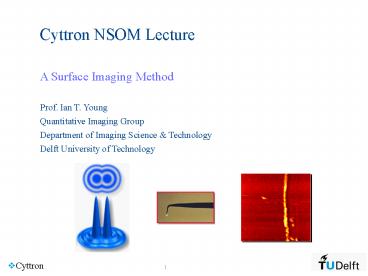Cyttron NSOM Lecture PowerPoint PPT Presentation
Title: Cyttron NSOM Lecture
1
Cyttron NSOM Lecture A Surface Imaging
Method Prof. Ian T. Young Quantitative Imaging
Group Department of Imaging Science
Technology Delft University of Technology
2
Theory Optical resolution is limited
- Methods that are based on lenses have limited
spatial resolution - Where does this result originate?
3
Basic Concepts - Wave Optics
- Interference
- Diffraction
Christiaan Huygens Treatise on Light
4
Numerical Aperture Resolution I
- The NA is one of the most important parameters of
an optical microscope. - It determines
- The amount of collected light
- The optical resolution
- But where does it originate?
5
Numerical Aperture Resolution II
- What is the intensity distribution for a 2-D
aperture ? I(x, y, z)?
- Sketching the result
6
Numerical Aperture Resolution III
- Where are the zeroes of the intensity function?
- Adding one final substitution approximation
- Gives
- For air, n 1
7
Numerical Aperture Resolution IV
- A point of light as object produces an Airy disk
as the 2-D image - Two points of light produce two Airy disks
- The size of the Airy disk(s) depends on the NA
and ?
8
Numerical Aperture Resolution IV
- A point of light as object produces an Airy disk
as the 2-D image - Two points of light produce two Airy disks
- The size of the Airy disk(s) depends on the NA
and ?
9
Numerical Aperture Resolution V
- A point of light as object produces an Airy disk
as the 2-D image - Two points of light produce two Airy disks
- The size of the Airy disk(s) depends on the NA
and ?
10
Typical Values
- A round aperture produces an Airy disk on the
screen - The size of the Airy disk(s) depends on the NA
and ? - Rayleigh criterion says resolution is
11
Practice High-resolution optical methods
250 nm
180 nm
30 nm
100 nm
30 nm
Garini et al, Curr Opin Biotech 2005. 16, 3-12
12
How can we overcome the diffraction limit??
Completely different approach NEAR FIELD
Measure VERY CLOSE to tip 10 nm
13
Example of a near-field tip
50 nm hole
14
Near Field Microscopy
But how does it work? It can only detect one
small point. ? Need to scan the surface ? need
scanning mechanism with 10 nm resolution It uses
piezoelectric elements (expand with voltage)
15
Piezoelectric motors
Material (example) Perovskite-type lead
zirconate titanate (PZT). Different
schemes single/multi layers high/low voltage
16
Near-field microscope feedback mechanism
Tuning fork Optical probe
quadrant detector
17
Near-field scanning optical microscope(NSOM or
SNOM)
The tip must be 10 nm from the sample
18
Tip atom interactionVan der Waals potential
Potential Energy
r
Repulsion
Attraction
r
19
NSOM working modes
Non-contact mode
Contact mode
Tapping mode
20
(No Transcript)
21
(No Transcript)
22
NSOM example of a Muscle Tissue
Topography
Near-field
23
Total Internal Reflection Microscopy
Principle Happens when light hit a surface ?gt?c
n1gtn2 Calculation of ?c for n11.5, n21.36 ?
Use Snells law
24
Total Internal Reflection Fieldcreates
evanescent field
z
25
Why is TIRF interesting?
Provides high resolution along z overcomes
wide-field limit
Limitation only measures the surface, Still
important for various applications.
26
TIRF microscopy
27
TIRF History
- Hirschfeld (1977)
- When light is reflected from a perfect mirror, a
small amount of light (the evanescent wave) goes
through to the other side of the mirror. - The thickness of the wave on the other side is
about ?/20, e.g. 25 nm.
Virometer An Optical Instrument for Visual
Observation, Measurement and Classification of
Free Viruses, Hirschfeld T, Block M, Mueller W,
J. Histochemistry Cytochemistry, 25719-723
(1977).
28
TIRF History II
- What can we measure in this thin excitation
field? - Dynamic movement of labeled biomolecules
29
TIRF examples
30
TIRF examples
Cells labeled (tubulin) imaged with wide-field
(Center panel) and TIRF illumination.
Right Overlay of images. Green wide field, red
TIRFGregg Gundersen, Columbia University
31
Advanced TIRF for single molecule detection
Setup Interference Calibration by
moving the slide
Cappello, G. Physical Review E 68, 2003.
32
Advanced TIRF Results
33
Hyper-spectral microscopy
Garini (1996) Using chromosome-specific
probes markers
DAPI
5 dyes are sufficient for 24 chromosomes
Multicolor spectral karyotyping of human
chromosomes, Schrock E, duManoir S, Veldman T,
Schoell B, Wienberg J, FergusonSmith MA, Ning Y,
Ledbetter DH, BarAm I, Soenksen D, Garini Y, Ried
T, Science 273494-497 (1996).
34
Hyper-spectral microscopy II
For every pixel (x,y) on the CCD camera a
complete spectrum is generated This permits
classification on the basis of color
35
Hyper-spectral microscopy III
- This, in turn, permits spectral karyotyping
36
FLIM
Arndt-Jovin (1979)
There is a distribution of times associated
with the return of an electron to the ground
state and the emission of a photon The
biochemical environment (e.g. pH, O2, Ca2) of
the fluorescent molecule can affect this
fluorescence lifetime
Dt 10 ns ? fluorescence lifetime
Fluorescence Decay Analysis in Solution and in
a Microscope of DNA and Chromosomes Stained with
Quinacrine, Arndt-Jovin DJ, Latt S, Striker SA,
Jovin TM, J. Histochemistry Cytochemistry,
2787-95 (1979).
37
FLIM
- There are several ways to measure this
phenomenon - Sinusoidal light source modulation (now with
LEDs!) - Pulse method
- Gated method
- PRBS light source modulation

